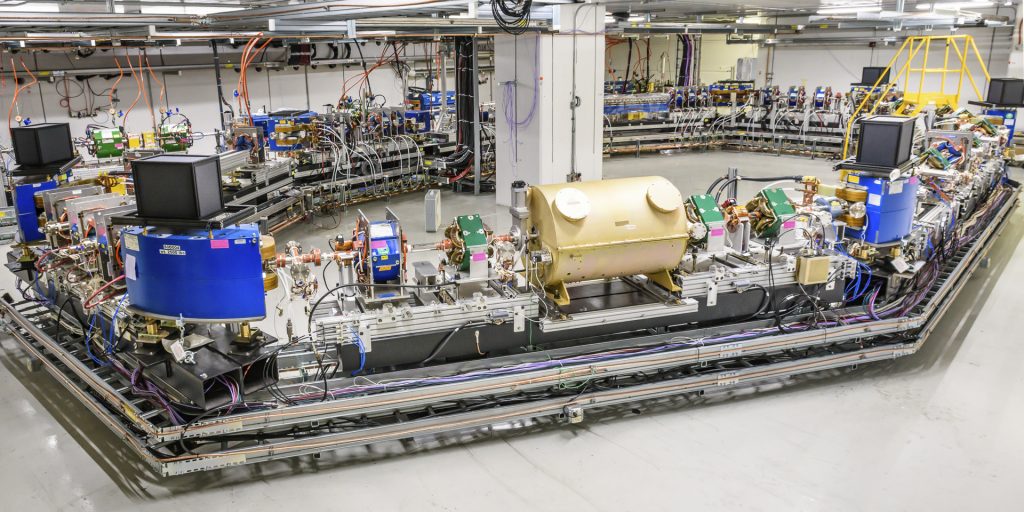For nearly a century, new frontiers in accelerator-based science have been enabled by advances in the field of accelerator science and technology. A team of researchers at Fermilab has been working in this area to develop the next generation of concepts and technologies for particle beam cooling and control, and now that work is gearing up for a serious expansion.
Jonathan Jarvis, a Peoples fellow and associate scientist at Fermi National Accelerator Laboratory, has been selected by the Department of Energy for a 2020 Early Career Research Award. The $2.5 million award will be spread out over five years.
“This technology has the potential to be used in any number of particle accelerator facilities around the world and would be a major advancement in accelerator science,” said Michael Lindgren, head of the Fermilab Accelerator Division. “I am absolutely convinced that Jonathan will do extremely well with this assistance from DOE.”
The technologies that Jarvis and his collaborators are developing are based on a concept called optical stochastic cooling. OSC is a descendant of a breakthrough technology, stochastic cooling, that was invented by Simon van der Meer at CERN. Stochastic cooling enabled the discovery of the W and Z bosons in 1983 and promptly earned van der Meer a share of the 1984 Nobel Prize in physics.
By cooling particle beams, physicists drive up beam intensity, or how tightly the particles are packed. The cooler the beam, the more dense it is, and the more opportunities it provides for producing rare physics phenomena.
Just like the gas molecules trapped inside a balloon, the beams in particle accelerators have a temperature. Place that balloon inside the freezer, and it will shrink a bit as the random motion of the gas molecules is reduced. While there aren’t exactly freezers for particle beams, accelerator scientists have a variety of ways to reduce that random thermal motion.
Stochastic cooling is a family of techniques in which the structure of a particle beam is measured and the resulting information is used to make small corrections to the beam particles.
“Imagine a beam with a single particle,” Jarvis said. “If you could accurately sense what that particle is doing, amplify that signal, and use it to kick the particle at a later point in the accelerator, then, in principle, you could remove its error completely.”
With an actual particle beam, such as the ones in a typical circular accelerator, the situation is a bit more complicated, but the basic principle is the same: Every pass through that system is like another moment in the freezer, reducing the particles’ random motion.
Conventional stochastic cooling uses microwaves to sample and kick the beam. This “slices” the beam into pieces that are many centimeters long and could contain millions or billions of particles. As a result, each particle’s tiny cooling signal is buried in the noise of its neighbors. The trick is to send the beam through the cooling system many times, randomizing the particles between passes, so that those tiny signals can build up and overcome the noise.
OSC, on the other hand, uses visible or infrared light to slice the beam into pieces that are thousands of times smaller, so each contains fewer particles. Fewer particles mean vastly fewer noisy neighbors and fewer trips needed through the cooling system. This has the potential to increase the cooling rate by a factor of up to 10,000 compared to conventional stochastic cooling.
OSC has been of interest to the accelerator community since the early 1990s, but there has never been an experimental demonstration of the concept. In 2017, Fermilab established the Fermilab Accelerator Science and Technology, or FAST, facility to tackle advanced problems in accelerator and beam physics. Its centerpiece is an electron/proton storage ring called IOTA, the Integrable Optics Test Accelerator. While IOTA’s primary focus is enabling technologies for high-intensity proton accelerators, its flexible design makes it an ideal facility for other advanced topics, such as OSC.
“Because FAST-IOTA is a dedicated facility for accelerator science and technology, we are well positioned for this sort of research and development,” Jarvis said. “IOTA was designed so that it could be quickly and completely reconfigured for a given high-priority research objective; that’s exactly what we are doing now for OSC.”
For the past few years Jarvis and his colleagues have been designing an experimental apparatus and procedures that will enable them to demonstrate and explore OSC for the first time. That foundational work is about to be put to the test. This month, they will start a new science run at IOTA dedicated to testing this prototype OSC system.

Jarvis and his colleagues will use IOTA to demonstrate and explore optical stochastic cooling for the first time. Photo: Giulio Stancari, Fermilab
But that demonstration is just the beginning. OSC still needs a variety of developments before it can be operationalized in other accelerators. Jarvis’s Early Career Research program focuses on those areas. One major element is the development of a high-gain optical amplifier and its required drive laser so that the light from the particle beam can be strengthened before making those corrective kicks. A new apparatus will also need to be developed to test this amplified version of OSC in IOTA. Other elements of the program include developing specialized optics to enhance the system’s performance and flexibility and using the physics of OSC as a more general tool for sensing and controlling particle beams.
The program also emphasizes the support of graduate students and postdoctoral researchers with both funding and research topics.
“This is an outstanding facility for training young researchers in our field. We’re large enough to work on high-impact topics, but small enough for them to be involved at every level of the research,” Jarvis said.
If all goes well, an amplified-OSC experiment will take place at IOTA within the next few years, and the system will then be paired with techniques from machine learning to develop powerful new tools for accelerator scientists to control and measure their beams.
“You can seldom point to a specific technology and accurately predict its returns in the long run, but we do know that accelerator-based science has consistently impacted a very wide range of fields and industries while also delivering tremendous understanding of the basic stuff of the universe,” Jarvis said. “The engine of that enterprise has always been the technologies, the concepts and the physics that we use to realize the next generation of accelerators.”
Fermilab accelerator science research is supported by the Department of Energy Office of Science.
Fermilab is supported by the Office of Science of the U.S. Department of Energy. The Office of Science is the single largest supporter of basic research in the physical sciences in the United States and is working to address some of the most pressing challenges of our time. For more information, visit science.energy.gov.




